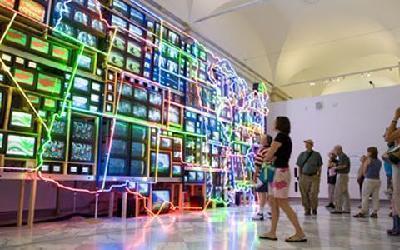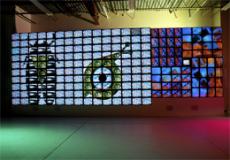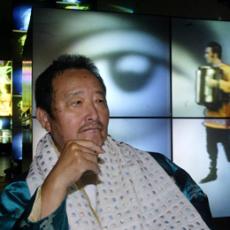
SHIRLEY GRIFFITH: I'm Shirley Griffith.
MARIO RITTER: And I'm Mario Ritter with EXPLORATIONS in VOA Special English. Nam June Paik is widely considered one of the first video artists. Today, video art is a rich and popular field in modern art. But in the 1960s, the use of television and television images to make art was very new and revolutionary. Nam June Paik helped turn the moving image into a common tool for artists to use as a form of expression. Today his works can be seen in the permanent collections of museums around the world.
(MUSIC)
SHIRLEY GRIFFITH: One place to experience the art of Nam June Paik is at the Smithsonian American Art Museum in Washington DC. There, visitors can see several of his works. One is a huge neon and video sculpture called "Electronic Superhighway: Continental US, Alaska, Hawaii." The sculpture was created in 1995. It is made up of 336 televisions, 50 DVD players, and over 170 meters of neon lighting.
The work measures about 12 meters wide and over four meters tall. The televisions and neon lighting form the shape of a map of the United States.
MARIO RITTER: Name June Paik used video imagery to represent each of the 50 states. For example, he chose to show parts of the movie "The Wizard of Oz" to represent the state of Kansas. Images from the life of civil rights leader Martin Luther King Junior are used to represent the state of Alabama. The many bright images move very quickly in a disorderly and energetic way. The sculpture shows how media images defined Nam June Paik's understanding of the United States and its many cultural expressions.
SHIRLEY GRIFFITH: Another of his works at the Smithsonian American Art Museum is called "Megatron/Matrix." It has 215 television screens that play videos. Each television shows fast-moving images of Korean folk traditions, modern dance and the 1988 Olympic games in Seoul. Larger moving images flow across the screens of each television, creating a magical effect.

An earlier work by Nam June Paik is called "The more the better." He made this work to mark the Olympics in Seoul, where the work was shown. This video sculpture makes use of over 1,000 televisions. They were placed one on top of another in a circular shape. The sculpture looks like a huge layered birthday cake.
(MUSIC)
MARIO RITTER: Nam June Paik was born in Korea in 1932. His family fled their country during the Korean War and moved first to Hong Kong, then to Japan. In college, Mr. Paik studied art and music history at the University of Tokyo. Later, he moved to Germany to study music at Munich University. There, he met the American composer John Cage. Mr. Cage was known for his experimental music and for using everyday sounds in his art. He had a big influence on the young Korean artist.
SHIRLEY GRIFFITH: Nam June Paik became part of an art movement known as Fluxus. Fluxus artists created works that were experimental, playful, and combined different art forms. Mr. Paik organized art events that combined his interest in experimental music with theatrical performance. He moved to New York City in 1964.

The year before, he provided artwork for a show in the West German city of Wuppertal. The show was called "Exposition of Music: Electronic Television." His work was said to be made up of 13 televisions in a room. Some of the televisions were turned off. Some had no picture. And others showed bent, changed images. Mr. Paik created those images by placing magnets near the television.
MARIO RITTER: One reporter described the Wuppertal show as a hugely important moment in art history. Jim Lewis of Slate.com said it marked the first time video images were freed from television. He said that television images were no longer only the property of governments or broadcast companies. Video could be used by anyone, and it could be a material for artists.
SHIRLEY GRIFFITH: Another development helped expand the possibilities of video art for Nam June Paik and others. This was the release in 1965 of the Portapak, made by Sony Corporation. This handheld video camera was light and easy to carry. It was also far less costly than movie and television cameras used by industry experts. The handheld video camera permitted anyone who could buy one to become a producer of images. This device helped open up the world of video to more artists.
In 1970, Nam June Paik and a friend invented a video synthesizer device. This helped him to change and move video tapes and television programs to create the fast-dancing images that are part of his work.
(MUSIC)
MARIO RITTER: Nam June Paik is well known for his huge, complex video works that involve many televisions. But the National Gallery of Art in Washington is currently holding an exhibit that shows a different side of the artist.
Harry Cooper is the head of the National Gallery of Art's modern and contemporary art department. He organized this exhibit. He says an important part of the artist's message was to reject the blind acceptance of television and its images. Instead, he says, Nam June Paik wanted people to take an active role in the media that is so much a part of modern life.
HARRY COOPER: "Behind all this was really a kind of political and cultural idea that we shouldn't just be consumers of experience, we should be producers of experience. We shouldn't just watch the world go by and accept the media images that we're given. And we shouldn't even just criticize them, but really try to make our own images. So it is a very democratic idea of being activists in the world of images."
SHIRLEY GRIFFITH: The National Gallery's exhibit includes 20 works by Nam June Paik.
The main work is called "One Candle, Candle Projection." Every morning, a museum worker lights a candle. A video camera sitting nearby records the candle all day as it slowly burns. About ten different projectors direct the image of the candle on different walls in the room. Some projections of the candle are small, other are very large. Some are high up on the wall, another is low to the ground. One image shows the burning candle in red, green and blue.
Harry Cooper of the National Gallery of Art says the work is both simple and complex.
HARRY COOPER: "In some ways it's classic Paik. That is, very complicated. Lots of stuff to look at, sometimes almost a kind of visual overload. But at the same time, we have this very simple image of a candle and that's all there is to look at."
SHIRLEY GRIFFITH: Mr. Cooper says the work is a reminder of Nam June Paik's interest in Zen Buddhism and in meditation.
HARRY COOPER: "So, there is this other side of Paik which is very quiet, very calm. Really the opposite of what we think of as the world of media that he was immersed in. So for me, 'One Candle' puts these two extremes and takes them together."

MARIO RITTER: Nam June Paik also made a series of works called TV Buddhas. One of these can be seen at the National Gallery exhibit. It is called "Standing Buddha with Outstretched Hand." The work is made up of a nearly life-size metal statue of Buddha. Nearby, a video camera records his image. The Buddha is facing four televisions placed one on top of another. Two of the televisions show an image of the statue taken by the video camera. The two other television screens show colorful moving images.
The exhibit also includes several works by Mr. Paik that have rarely been exhibited - his drawings.
HARRY COOPER: "It turns out this is one way he came up with ideas, making notes to himself, playing on paper with ideas and materials. For me, these different kinds of drawings all have to do with his thoughts about television, what kind of thing it is, what kind of medium it is."
SHIRLEY GRIFFITH: Mr. Cooper says many people have seen the exhibit. He says he often finds visitors sitting on the floor, looking at the walls and just "hanging out" and enjoying the art.
HARRY COOPER: "People have been surprised to see this aspect of Paik's work focused on because they are used to seeing the big banks of televisions with a lot of dancing and twisting images. I wanted to present a different kind of work that is more meditative. So I think people come out, you know, hopefully a little surprised and with a larger view of what he was all about."
SHIRLEY GRIFFITH: Nam June Paik died in 2006. But his works continue to influence new generations of artists and art lovers.
(MUSIC)
MARIO RITTER: This program was written and produced by Dana Demange. I'm Mario Ritter.
SHIRLEY GRIFFITH: And I'm Shirley Griffith. For pictures of the art of Nam June Paik, visit our website at voaspecialenglish.com You can also read and listen to our programs and get podcasts. Join us again next week for EXPLORATIONS in VOA Special English.
YouTube play creative video competition draws 23,000 entries
深圳現(xiàn)場(chǎng)——中英行為藝術(shù)文化交流
Director Tim Burton’s strange art on exhibit in New York
(來源:VOA 編輯:崔旭燕)
